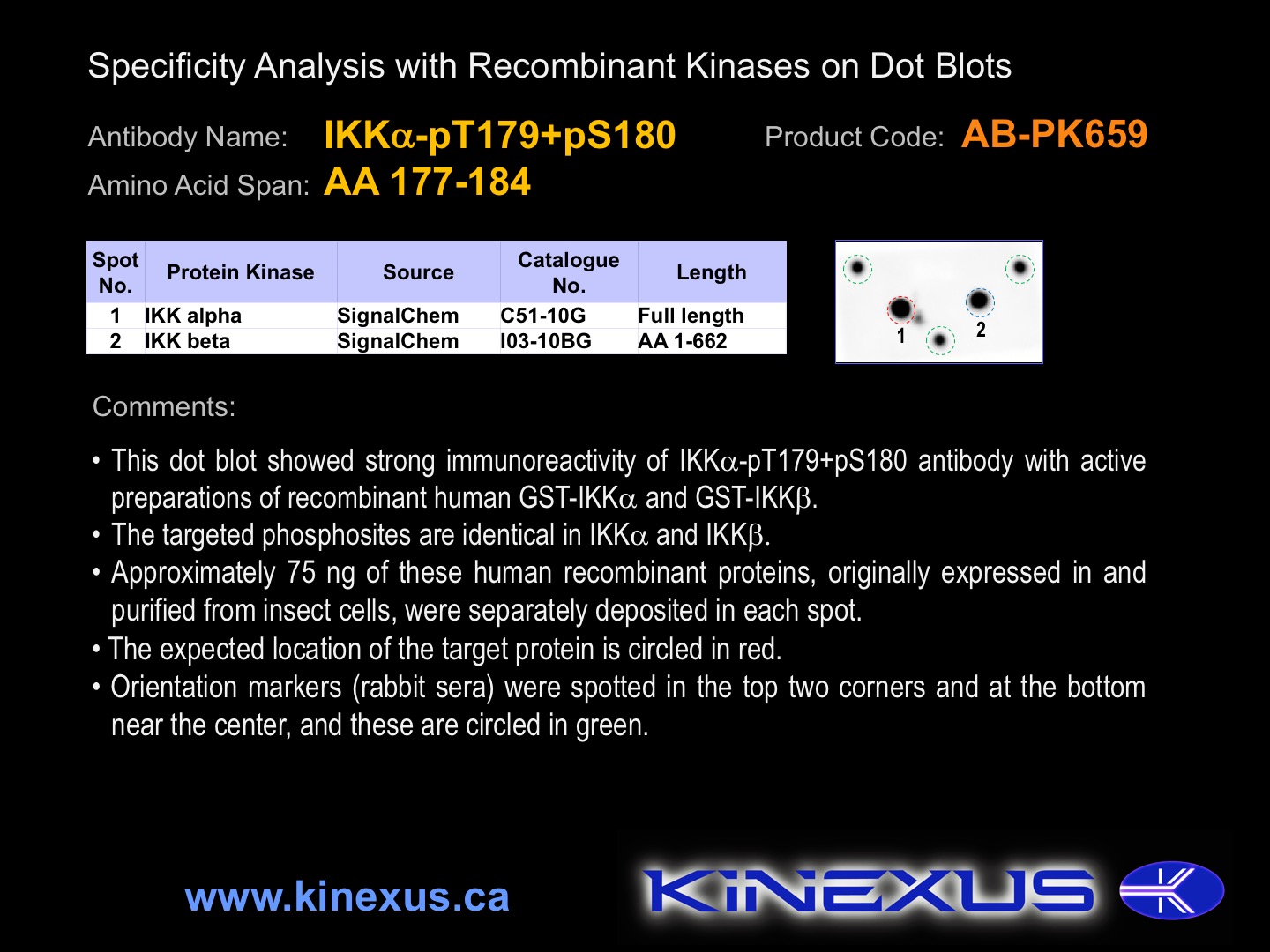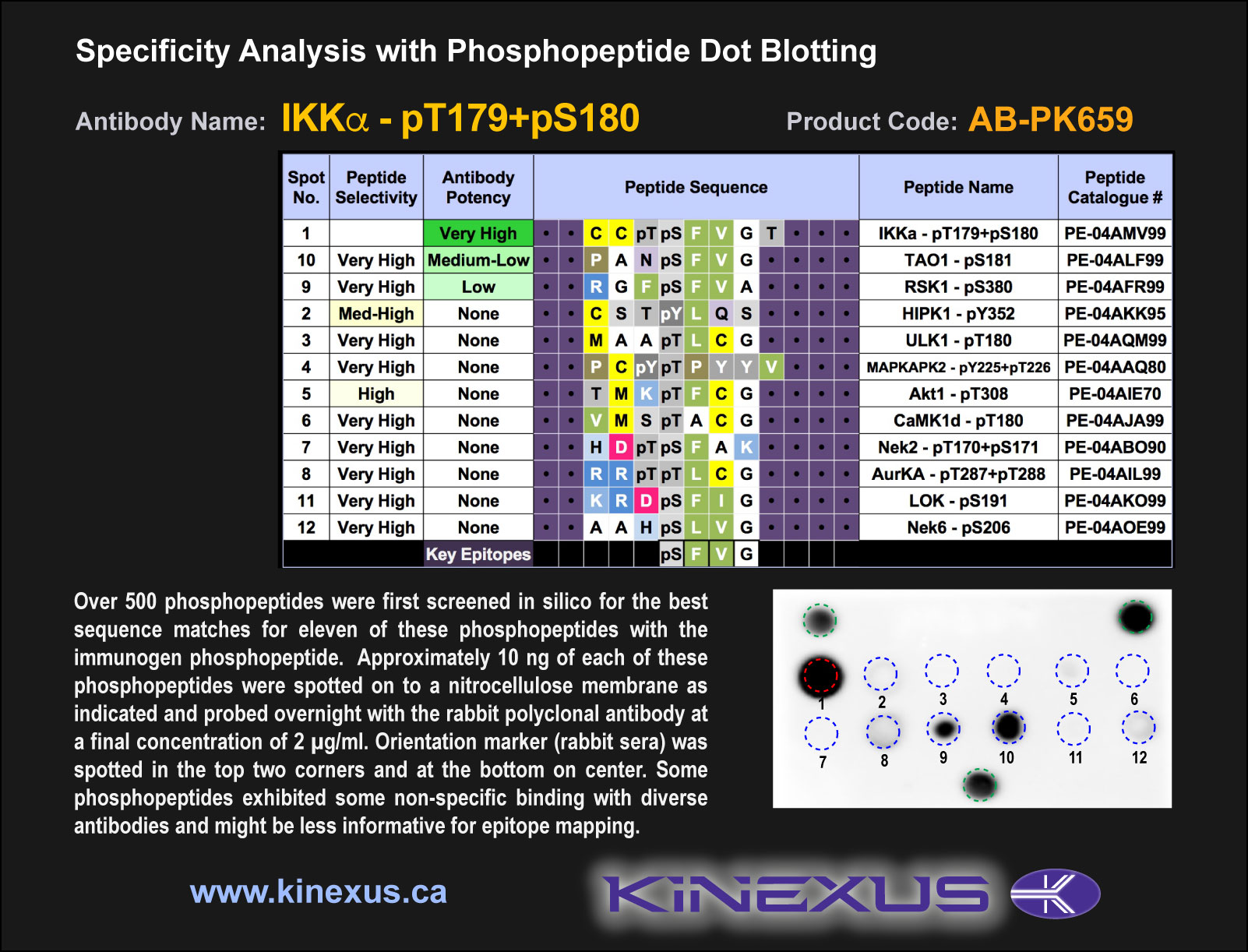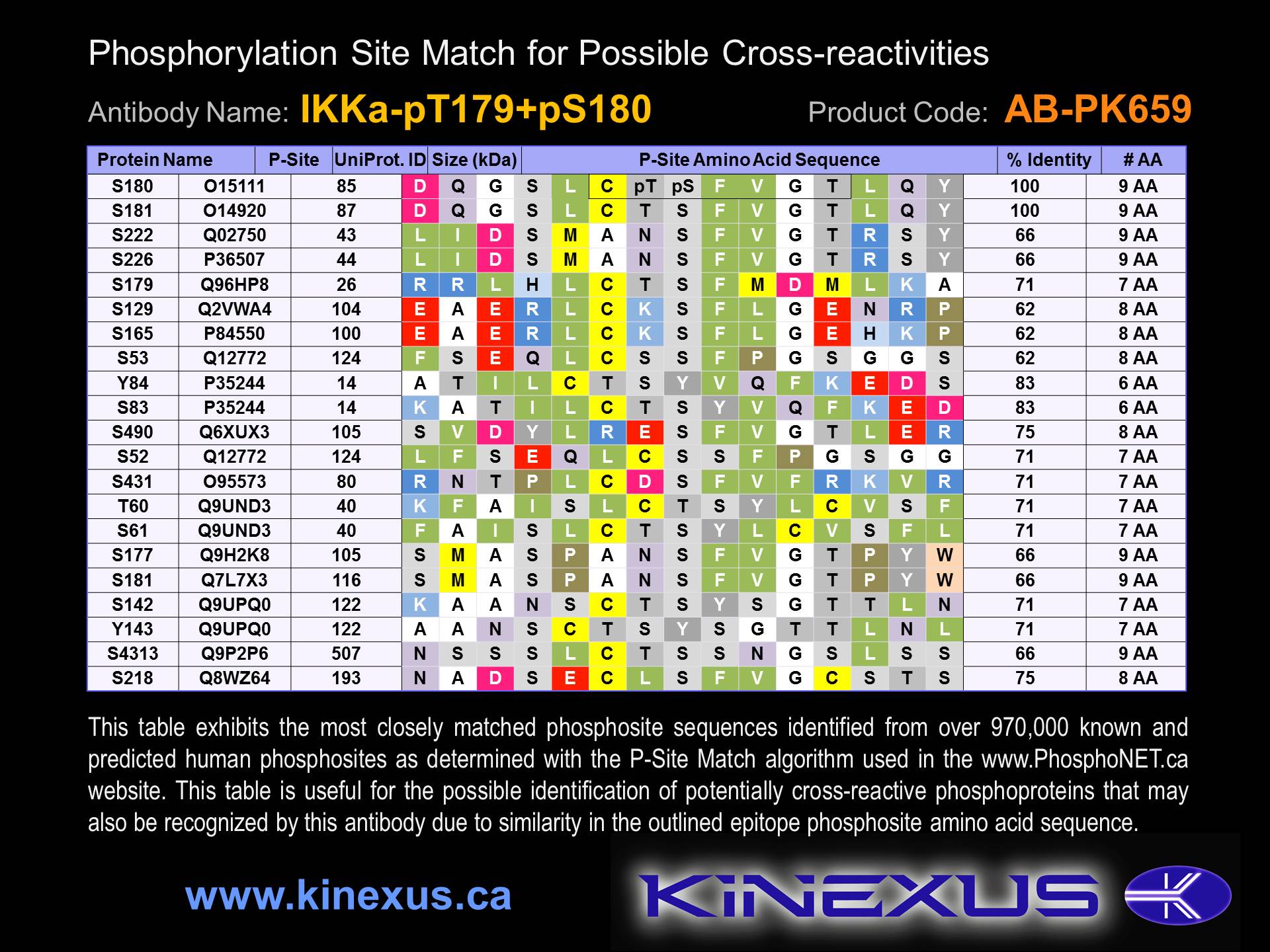Product Name: IKKa-pT179+pS180
Product Number: AB-PK659
| Size: | 25 µg | Price: | 89.00 | |
| $US |
Target Full Name: Inhibitor of NF-kappa-B protein-serine kinase alpha (CHUK)
Target Alias: CHUK; Conserved helix-loop-helix ubiquitous kinase; I kappa-B kinase alpha; IkappaB kinase; I-kappa-B kinase 1; IkBKA; IKK1; IKK-alpha; NFKBIKA
Product Type Specific: Protein kinase phosphosite-specific antibody
Antibody Code: PK659
Antibody Target Type: Phosphosite-specific
Antibody Phosphosite: T179+S180
Protein UniProt: O15111
Protein SigNET: O15111
Antibody Type: Polyclonal
Antibody Host Species: Rabbit
Target Alias: CHUK; Conserved helix-loop-helix ubiquitous kinase; I kappa-B kinase alpha; IkappaB kinase; I-kappa-B kinase 1; IkBKA; IKK1; IKK-alpha; NFKBIKA
Product Type Specific: Protein kinase phosphosite-specific antibody
Antibody Code: PK659
Antibody Target Type: Phosphosite-specific
Antibody Phosphosite: T179+S180
Protein UniProt: O15111
Protein SigNET: O15111
Antibody Type: Polyclonal
Antibody Host Species: Rabbit
Antibody Immunogen Source: Human IKKa (IkBKA) sequence peptide Cat. No.: PE-04AMV99
Antibody Immunogen Sequence: CC(pT)(pS)FVGT
Antibody Immunogen Description: Corresponds to amino acid residues C177 to T184; In the protein kinase catalytic domain activation T loop region between subdomains VII and VIII.
Antibody Immunogen Sequence: CC(pT)(pS)FVGT
Antibody Immunogen Description: Corresponds to amino acid residues C177 to T184; In the protein kinase catalytic domain activation T loop region between subdomains VII and VIII.
Production Method: The immunizing peptide was produced by solid phase synthesis on a multipep peptide synthesizer and purified by reverse-phase hplc chromatography. Purity was assessed by analytical hplc and the amino acid sequence confirmed by mass spectrometry analysis. This peptide was coupled to KLH prior to immunization into rabbits. New Zealand White rabbits were subcutaneously injected with KLH-coupled immunizing peptide every 4 weeks for 4 months. The sera from these animals was applied onto an agarose column to which the immunogen peptide was thio-linked. Antibody was eluted from the column with 0.1 M glycine, pH 2.5. Subsequently, the antibody solution was neutralized to pH 7.0 with saturated Tris.This antibody was also subject to negative purification over phosphotyrosine-agarose.
Antibody Modification: Unconjugated. Contact KInexus if you are interest in having the antibody biotinylated or coupled with fluorescent dyes.
Antibody Modification: Unconjugated. Contact KInexus if you are interest in having the antibody biotinylated or coupled with fluorescent dyes.
Antibody Concentration: 1 mg/ml
Storage Buffer: Phosphate buffered saline pH 7.4, 0.05% Thimerasol
Storage Conditions: For long term storage, keep frozen at -40°C or lower. Stock solution can be kept at +4°C for more than 3 months. Avoid repeated freeze-thaw cycles.
Product Use: Western blotting | Antibody microarray
Antibody Dilution Recommended: 2 µg/ml for immunoblotting
Antibody Potency: Strong immunoreactivity of a target-sized protein by Western blotting in human lung. Medium-weak immunoreactivity of a target-sized protein by Western blotting in Jurkat, A431, A549, Hek293 and T98G cells. Very strong immunoreactivity with immunogen peptide on dot blots.
Antibody Species Reactivity: Human
Storage Buffer: Phosphate buffered saline pH 7.4, 0.05% Thimerasol
Storage Conditions: For long term storage, keep frozen at -40°C or lower. Stock solution can be kept at +4°C for more than 3 months. Avoid repeated freeze-thaw cycles.
Product Use: Western blotting | Antibody microarray
Antibody Dilution Recommended: 2 µg/ml for immunoblotting
Antibody Potency: Strong immunoreactivity of a target-sized protein by Western blotting in human lung. Medium-weak immunoreactivity of a target-sized protein by Western blotting in Jurkat, A431, A549, Hek293 and T98G cells. Very strong immunoreactivity with immunogen peptide on dot blots.
Antibody Species Reactivity: Human
Antibody Positive Control: The observed molecular mass of the processed target protein on SDS-PAGE gels is reported to be around 85-95 kDa.
Antibody Specificity: Medium-high
Antibody Cross Reactivity: In A549 cells, EGF increases an 85 kDa immunoreactive protein (probably target) and EGF decreases 75 kDa immunoreactive protein. In HEK-293 cells, phenylarsine oxide (PAO) decreases 100, 80 + 35 kDa immunoreactive proteins; in HeLa cells, phenylarsine oxide (PAO) decreases 110 +80 kDa immunoreactive proteins; in Jurkat cells, phenylarsine oxide (PAO) decreases 110 + 75 kDa immunoreactive proteins.
Related Product 1: IKKa-pT179+pS180 blocking peptide
Related Product 2: IKKb-BCT pan-specific antibody (Cat. No.: AB-NK076-5)
Related Product 3: IKKb-NT pan-specific antibody (Cat. No.: AB-NK076-6)
Antibody Specificity: Medium-high
Antibody Cross Reactivity: In A549 cells, EGF increases an 85 kDa immunoreactive protein (probably target) and EGF decreases 75 kDa immunoreactive protein. In HEK-293 cells, phenylarsine oxide (PAO) decreases 100, 80 + 35 kDa immunoreactive proteins; in HeLa cells, phenylarsine oxide (PAO) decreases 110 +80 kDa immunoreactive proteins; in Jurkat cells, phenylarsine oxide (PAO) decreases 110 + 75 kDa immunoreactive proteins.
Related Product 1: IKKa-pT179+pS180 blocking peptide
Related Product 2: IKKb-BCT pan-specific antibody (Cat. No.: AB-NK076-5)
Related Product 3: IKKb-NT pan-specific antibody (Cat. No.: AB-NK076-6)
Related Product 4: IKKe-pS172 phosphosite-specific antibody (Cat. No.: AB-PK660)
Related Product 5: IKKSelectide - IKKa (CHUK) protein kinase substrate peptide
Related Product 5: IKKSelectide - IKKa (CHUK) protein kinase substrate peptide
Scientific Background: IKKa (IKBKA, CHUK)) is a protein-serine/threonine kinase of the Other group and IKK family. It is involved in NF-kappa-B pathway, which activates multiple stress stimuli including inflammatory cytokines, infection, and DNA damage. The activity of the kinase enables for NF-kappa-B to enter the nucleus and stimulate the transcription of genes involved in the immune response, control of cell growth, and cellular protection against apoptosis. It is Inhibited by phosphorylation at S733, S740, and S750.
Figure 1. Dot blotting IKKa-pT179+pS180 antibody with recombinant purified proteins.
Figure 2. Epitope mapping of IKKa-pT179+pS180 antibody with similar phosphopeptides on dot blots.
© Kinexus Bioinformatics Corporation 2017




